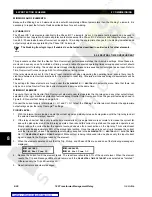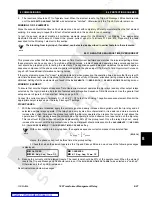
GE Multilin
745 Transformer Management Relay
8-33
8 COMMISSIONING
8.5 PROTECTION SCHEMES
8
7.
For timing tests, the signal generator must be capable of triggering into step-wise changing of frequency or ramping
down to a pre-selected frequency in only a few milliseconds. Connect the Signal Source and Timer Start triggers as
shown in Figure 8–12: Frequency Element Testing on page 8–29.
8.
Set the current to rated CT secondary value, no voltage connection, and the pre-trigger frequency to the nominal fre-
quency (60 or 50 Hz).
9.
Set the post-trigger to 0.5 Hz above the setting of the Overfrequency element. Reset all targets and relays, if neces-
sary. Reset the timer.
10. Initiate the frequency step and timer start. The Interval Timer records the element operating time. Compare this time to
the
S4 ELEMENTS
ÖØ
FREQUENCY
ÖØ
OVERFREQUENCY
ÖØ
OVERFREQUENCY DELAY
setting:
11. Provided that the operate times are not scattered over a wide range, it may be desirable to repeat this test several
times and average the results. If there is a wide scatter, verify the test setup and ensure the signal source behaves in a
consistent manner.
The blocking from logic input, if enabled, can be tested as described in earlier tests for other elements.
e) FREQUENCY DECAY RATE
A high-quality programmable function generator is required to verify this element. Since the frequency rates of
change are measured over a narrow range, the test instrumentation must accurately simulate frequency decay
rates without any significant jitter. It is the experience of GE Multilin that some commercial dedicated relay test
equipment with built-in frequency ramping functions is not accurate enough to verify the 745 performance.
Disable all protection functions except the Frequency Decay function. Verify that settings match in-service requirements.
The settings are entered and modified in the
S4 ELEMENTS
ÖØ
FREQUENCY
ÖØ
FREQUENCY DECAY
setpoints menu.
The following procedures are for the Frequency Decay Rate 1 element. They can be applied to the Frequency Decay Rate
2, 3, and 4 elements as well, making the necessary changes where appropriate.
VOLTAGE INPUT FUNCTION (VOLTAGE INPUT ENABLED):
1.
Use a frequency-ramping programmable voltage/current source connected to terminals C11 and C12 for the voltage
signal and H1 and G1 for the current signal. Set the frequency to 60.00 Hz (or 50.00 Hz) and the voltage amplitude to
the rated VT secondary voltage. Set the current amplitude to rated CT secondary (
Note: if current sensing is disabled
for this element, the current signal is not required for the tests).
Monitor the appropriate trip and auxiliary relays. Reset
all alarms and indications on the relay. The relay display should remain unchanged with no trip indications.
2.
Program the function generator to simulate a frequency rate-of-change just above Rate 1. The start frequency should
be the nominal frequency of the relay; the end frequency must be below the Frequency Decay Threshold if the relay is
to operate. Note that operation occurs if the rate criterion is satisfied and the frequency is below the threshold.
3.
Initiate ramping action and verify element operation once the frequency drops below the threshold.
4.
Check that the Trip and Pickup LEDs are on and one of the following trip messages is displayed:
If the target was selected as “Latched”, the Trip LED and the message remain on.
5.
Reduce the voltage to below the
S4 ELEMENTS
ÖØ
FREQUENCY
ÖØ
FREQUENCY DECAY
ÖØ
MINIMUM OPERATING VOLT-
AGE
voltage supervision level.
6.
Repeat ramping action and verify that element does not operate.
If the voltage supervision level has been set to 0.00,
the element continues to operate correctly down to approximately 2% or nominal.
7.
Return voltage to nominal value.
8.
If current sensing is enabled, set the current level below the
S4 ELEMENTS
ÖØ
FREQUENCY
ÖØ
FREQUENCY DECAY
ÖØ
MINIMUM OPERATING CURRENT
value.
9.
Repeat ramping action and verify that element does not operate.
10. For timing tests, an approximate operate time is obtained if a timer is triggered at the same time as the ramping action
and the time interval between the trigger point and the relay operation measured. From that measured time, subtract
the time required for the frequency to reach the threshold value.
LATCHED
Freq Decay Rate 1
OPERATED
Freq Decay Rate 1
NOTE
NOTE












































